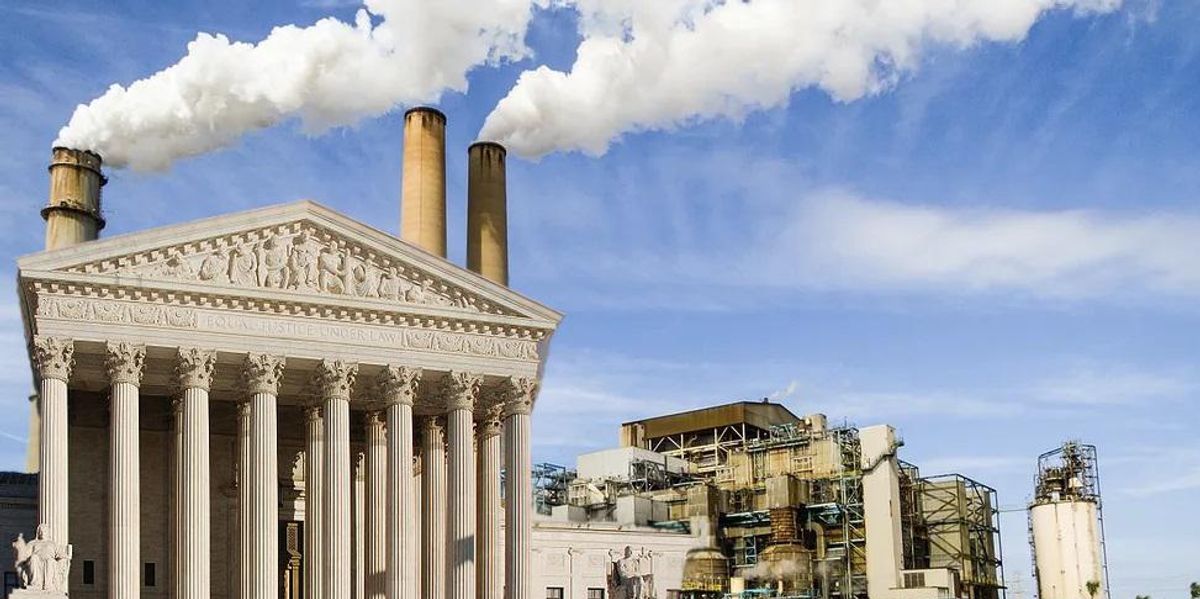There’s been a lot of buzz about an article in the New York Times Monday that suggested that the Inflation Reduction Act includes a brilliant workaround to June’s Supreme Court decision that sharply limited the Environmental Protection Agency’s authority to regulate greenhouse emissions. Specifically, the bill amends the Clean Air Act to specify that carbon dioxide and other greenhouse gases, are “air pollutants” under the VClean Air Act. Prior court and regulatory actions had already given the EPA the ability to regulate greenhouse gases, but now Congress has specified that authority in law.
Unfortunately, the Times makes that very welcome improvement sound like the IRA has completely undone the Court’s decision in West Virginia v. EPA. Unfortunately, that’s not so: It’s a great change, but the IRA doesn’t actually touch that case’s far bigger roadblock to addressing climate change. Let’s jump in and explainer!
What The New York Times Got Right, And Didn’t
The Times’s discussion of what the IRA does for the EPA goes wobbly right in the lede:
When the Supreme Court restricted the ability of the Environmental Protection Agency to fight climate change this year, the reason it gave was that Congress had never granted the agency the broad authority to shift America away from burning fossil fuels.
Now it has.
The piece goes on to explain the law’s amendment to the Clean Air Act, which establishes the EPA’s authority to regulate pollution, and says the clarification that greenhouse gases are air pollution should strengthen the agency against future lawsuits. That part’s good! The problem is with that bit about Congress not having granted the EPA the “broad authority to shift America away from burning fossil fuels.”
University of Michigan Law School prof Rachel Rothschild explained in a Twitter thread yesterday that the changes to the Clean Air Act are terrific and needed, but still don’t give the EPA the ability to force utilities to ditch fossil fuels and switch to renewables. Rothschild clarifies that the case didn’t turn on whether the EPA could regulate greenhouse gases. Rather, Rothschild notes,
the Court held that EPA could not require states to shift away from heavily polluting coal-fired power plants to cleaner sources of energy. This type of “generation shifting” approach was found to be a “major question” that required specific authorization from Congress.
The Inflation Reduction Act’s new language defining GHGs as air pollutants does not provide a clear statement on “generation shifting” that the Supreme Court said is required.
And it’s that kind of authority, to mandate that the power sector shift from fossil fuels to renewables, that would do the most good the most quickly to reduce carbon emissions. Electricity generation accounts for a quarter of all US greenhouse emissions, according to the EPA.
Rothschild does note that she thinks the Court’s reasoning in West Virginia is “deeply flawed and indefensible,” and that the EPA should already have the power to mandate “generation shifting,” but we’re stuck with the Court’s decision, meaning that Congress would have to pass legislation that directly gives the EPA such authority.
And sorry, amending the Clean Air Act to govern greenhouse gases simply doesn’t accomplish that.
This Is Still Good For The EPA
As the Times story points out, the language giving the EPA explicit authority to regulate CO2 “had appeared in an early version of the climate and tax package that passed the House in November” — that would be the Build Back Better Act — and it was retained in the version of the legislation that was ultimately passed. That says to us that the legislation anticipated that the Supremes might strike down the EPA’s ability to regulate carbon emissions, although that’s not actually what happened.
Instead, the Court left in place the agency’s ability to regulate individual power plants’ emissions, but barred it from “Capping carbon dioxide emissions at a level that will force a nationwide transition away from the use of coal to generate electricity,” ruling that Congress would have to explicitly order such a change.
Sen. Tom Carper (D-Delaware), who made sure the revisions made it into the IRA, touted the IRA’s capacity to address a wide range of carbon emissions under the amendment to the Clean Air Act:
“The language, we think, makes pretty clear that greenhouse gases are pollutants under the Clean Air Act.” […] With the new law, he added, there are “no ifs, ands or buts” that Congress has told federal agencies to tackle carbon dioxide, methane and other heat-trapping emissions from power plants, automobiles and oil wells.
Vermont Law School environmental law professor Patrick Parmenteau explains that even though the IRA won’t undo the West Virginia ruling, it will nonetheless “strengthen EPA’s ability going forward to take stronger actions under the Clean Air Act to reduce greenhouse gases.”
The act not only provides substantial increases in EPA’s budget across a wide range of air pollution programs, it also, for the first time, explicitly defines greenhouse gases to include the six specific gases that the EPA determined in 2009 pose a risk to public health and welfare. That 2009 “endangerment finding” was upheld by the Supreme Court in the 2014 case Utility Air Regulatory Group v EPA.
That alone should head off future challenges to the EPA’s authority to regulate greenhouse gases, and while under the Roberts Court, constitutional law increasingly feels like Calvinball, the EPA may have a stronger hand in coming litigation:
Challenges to EPA’s forthcoming rules replacing the Clean Power Plan, regulating methane emissions from oil and gas operations, tightening tailpipe emission and fuel economy standards, and so on can be expected. But at least now there is clear legislative direction from Congress for the EPA to take bold action needed to meet the profound challenge of climate change and transition to a sustainable economy.
Republicans Mad Anyway
While the IRA doesn’t actually blast away the West Virginia decision in a puff of chlorophyll (smoke would be bad for the environment), Republicans sure panicked about what it will do. On Fox Business Channel, Sen. Ted Cruz (R-Texas) insisted — incorrectly, because Ted Cruz — that the tricksy Democrats actually had sneaked a sneaky end run around the Court’s decision into the law, claiming, “It’s buried in there […] The Democrats are trying to overturn the Supreme Court’s West Virginia vs. EPA victory.”
In the Senate, Republicans fought the change to the bitter end, trying to convince the Senate parliamentarian that any amendment to the Clean Air Act would violate the weird rules that govern reconciliation bills. The parliamentarian, Elizabeth MacDonough, okayed the regulatory language all the same, and now it’s the law.
So if you’ve seen people on Twitter (or in Tabs) crowing about how the IRA reversed the West Virginia decision, their confusion is understandable because of that Times article. Now all we need to do — easy peasy! — is hold the House and expand the number of Democrats in the Senate, then git rid of the filibuster, and then authorize the EPA to mandate the “generation shifting” changes to the nation’s electricity sector.
After that, brunch.
[NYT / The Conversation / Rachel Rothschild on Twitter]
Do your Amazon shopping through this link, because reasons.
If you can, please give $5 or $10 a month so we can keep you up to date on all the things the New York Times gets wrong.























































![5 Ways to Improve Your LinkedIn Marketing Efforts in 2025 [Infographic] 5 Ways to Improve Your LinkedIn Marketing Efforts in 2025 [Infographic]](https://imgproxy.divecdn.com/Hv-m77iIkXSAtB3IEwA3XAuouMwkZApIeDGDnLy5Yhs/g:ce/rs:fit:770:435/Z3M6Ly9kaXZlc2l0ZS1zdG9yYWdlL2RpdmVpbWFnZS9saW5rZWRpbl9zdHJhdGVneV9pbmZvMi5wbmc=.webp)















